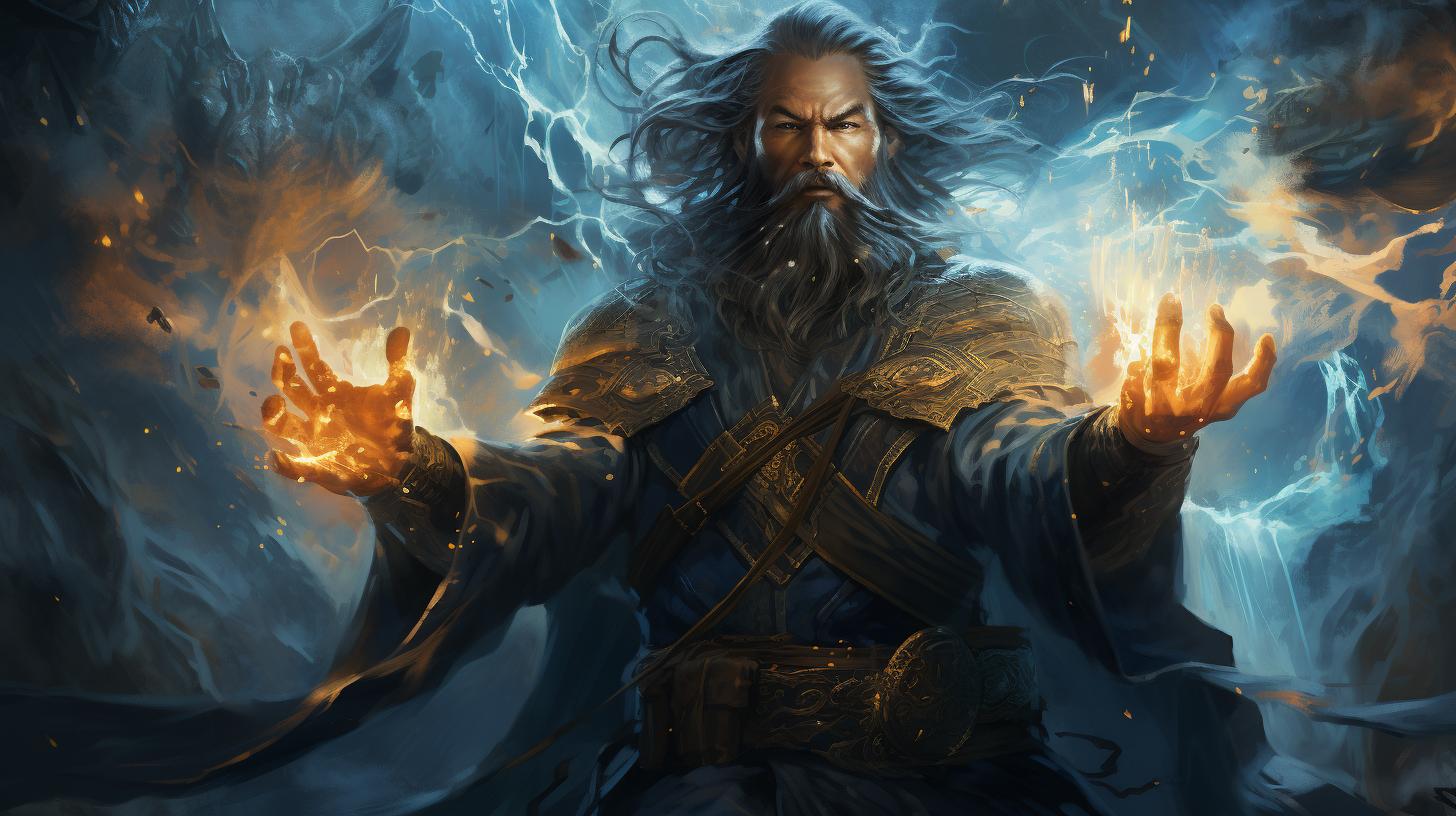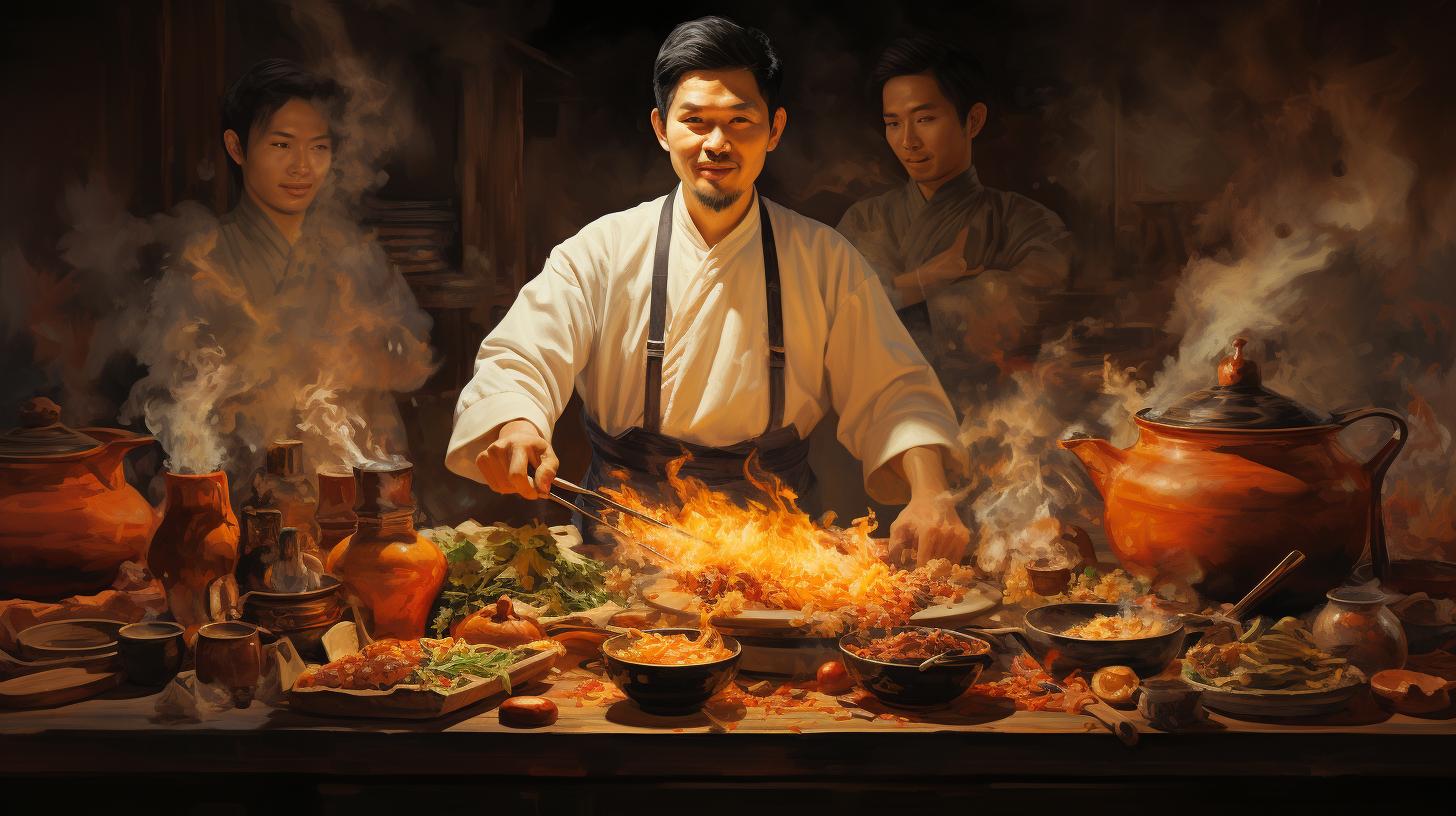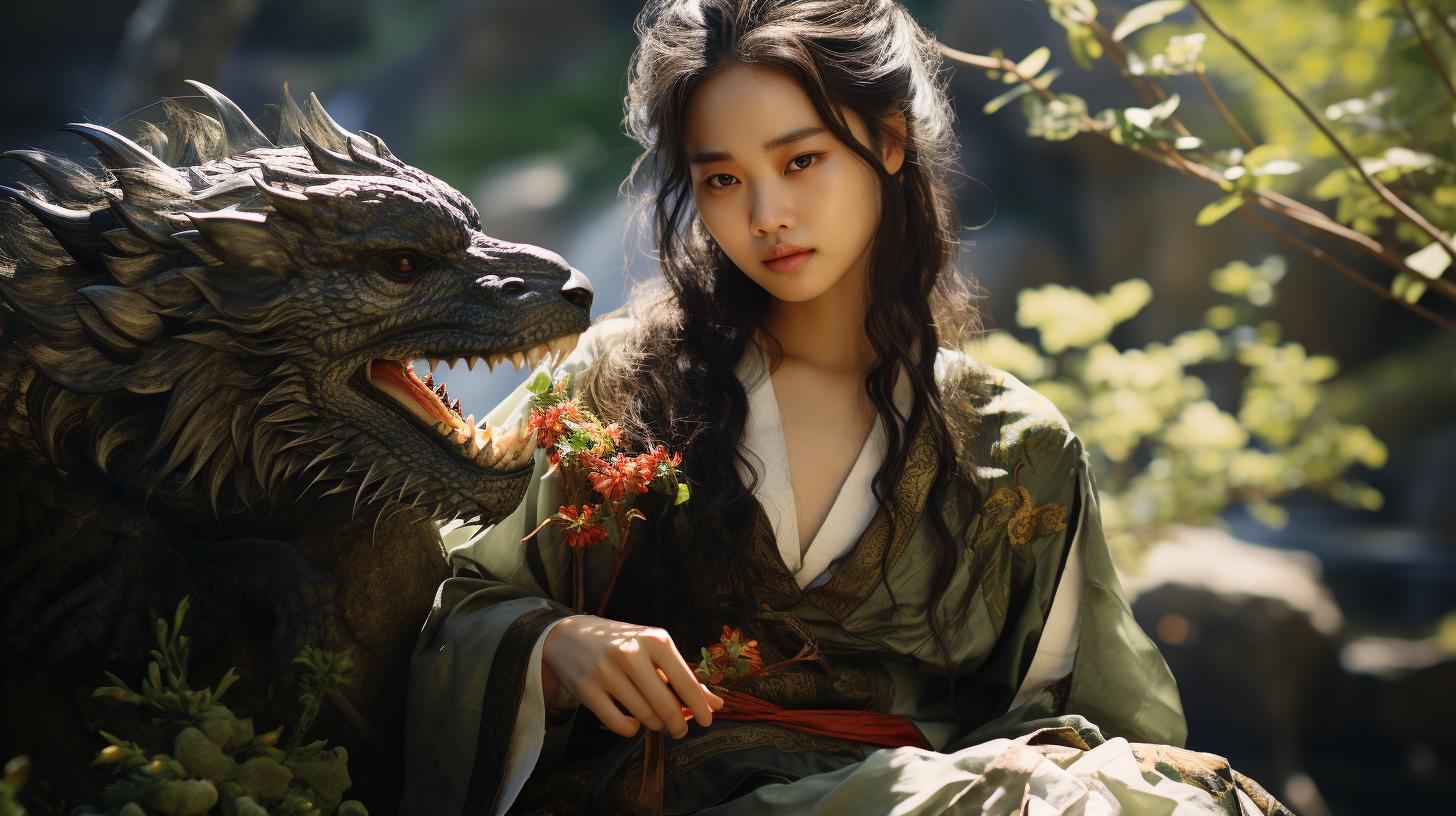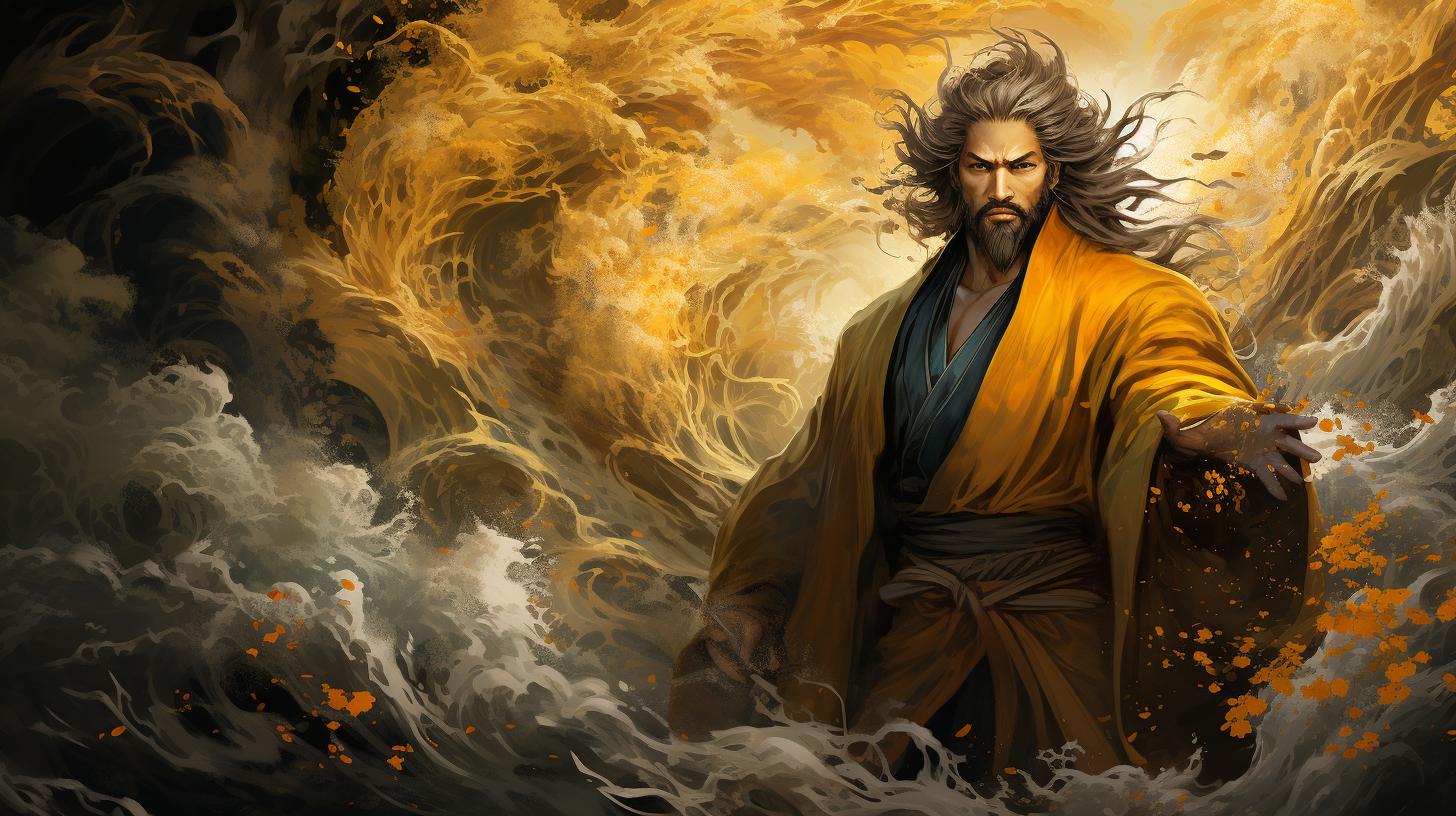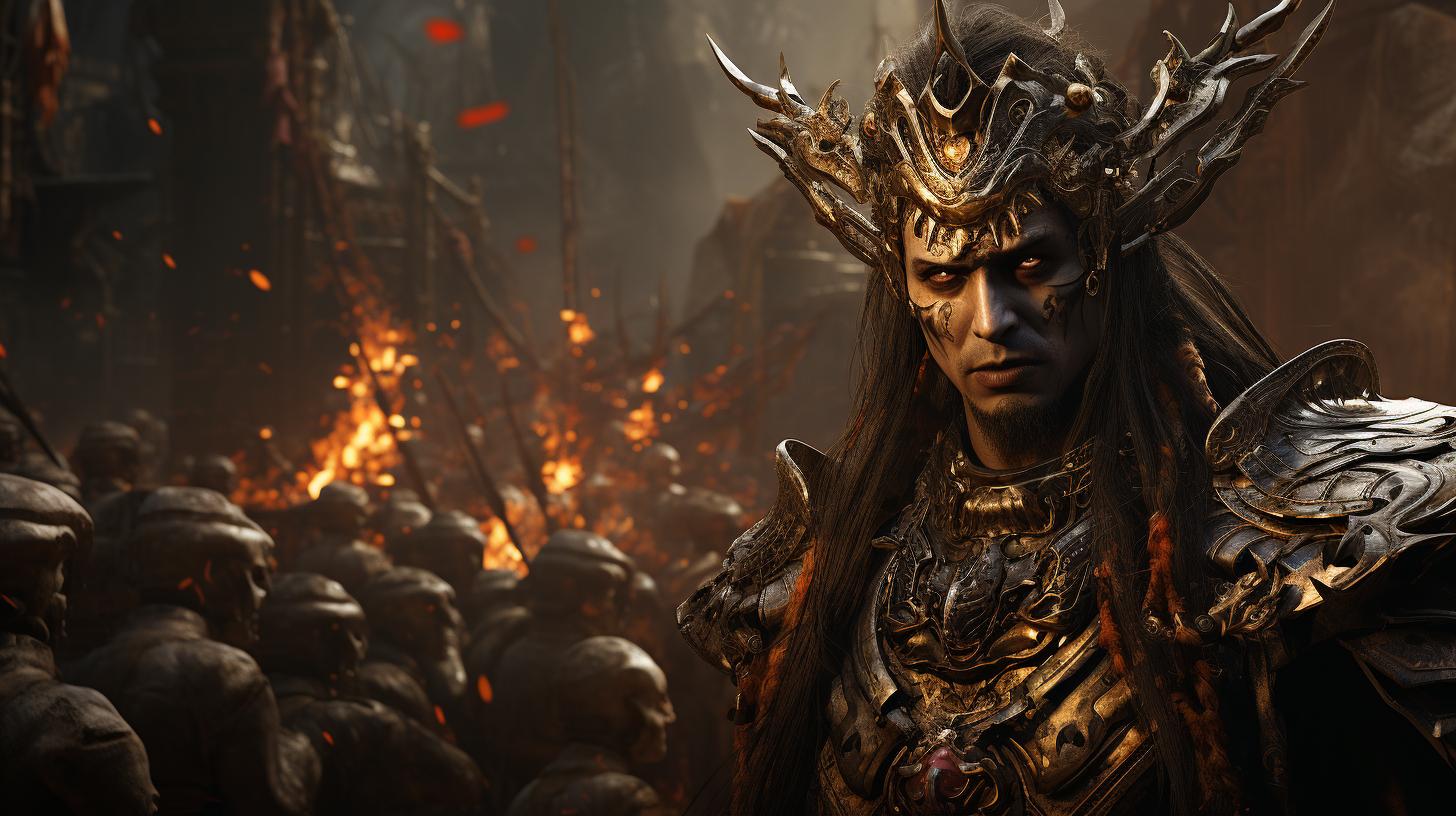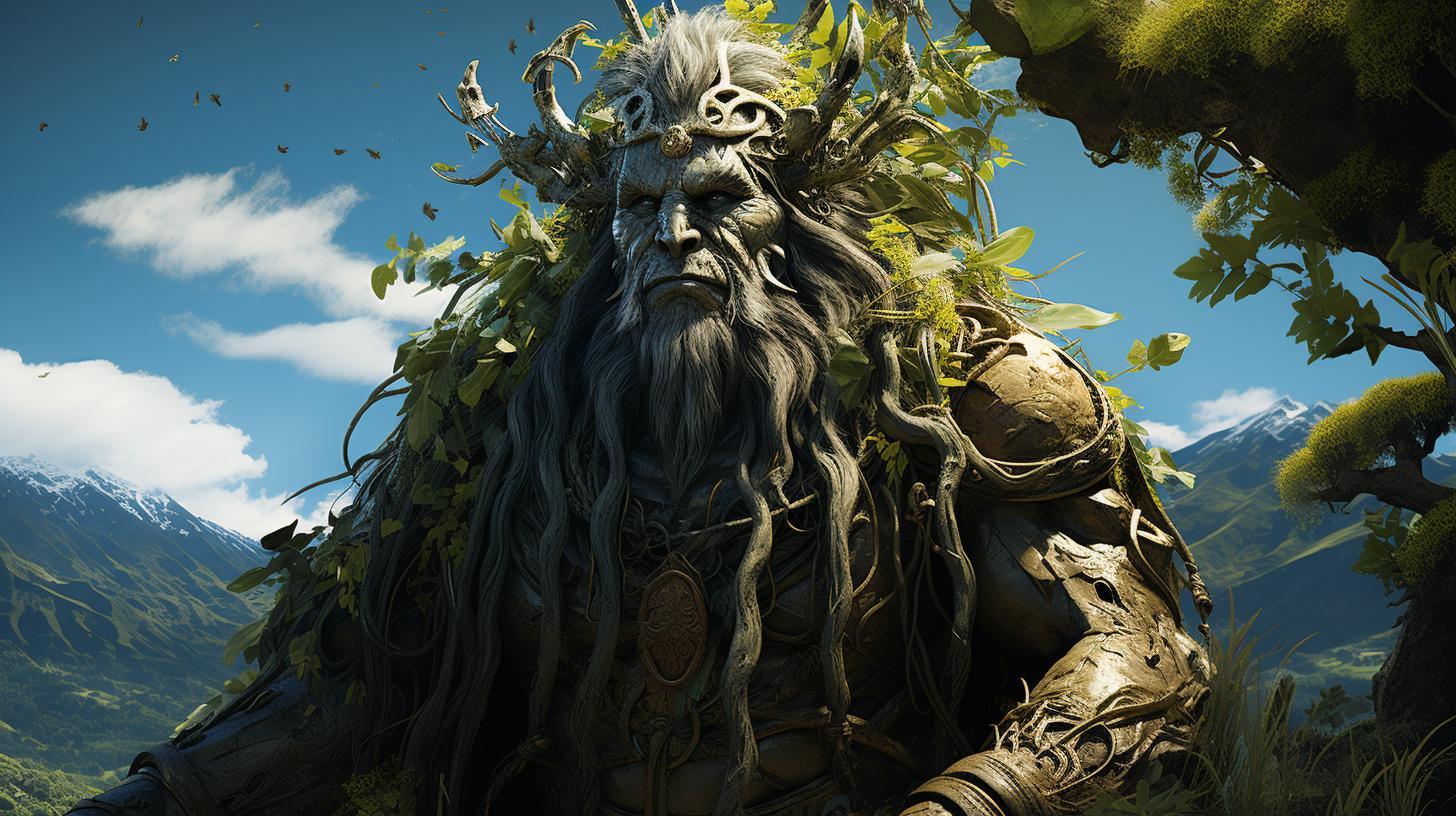Leigong: The Chinese God of Thunder and Lightning Unveiled – Exploring the Mythology
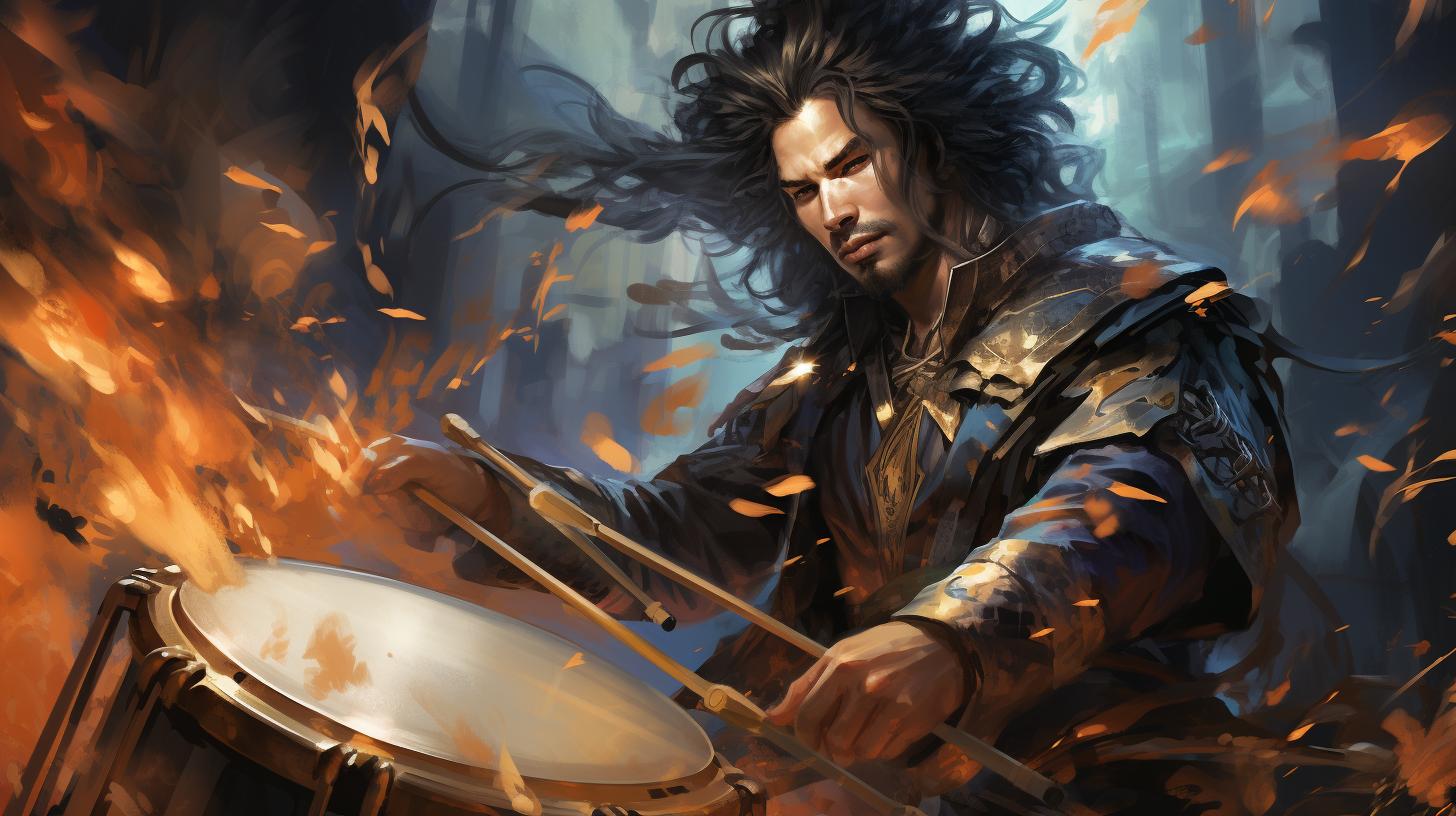
Leigong, the Chinese god of thunder and lightning, holds significant importance in Chinese mythology and folklore. Known for his fearsome appearance, with claws, bat wings, and a blue body, Leigong is responsible for punishing wrongdoers and evil spirits who harm humanity.
Alongside his divine assistants, he controls natural phenomena such as rain, clouds, and winds. Revered by many practitioners, Leigong is regarded as a ruthless character assessor and plays a significant role in the classic Chinese novel, ‘La Investidura de los Dioses.’
Explore the captivating mythology and enduring influence of Leigong in Chinese culture and beyond.
History and Origins of Leigong
Leigong, the Chinese god of thunder and lightning, has a rich history dating back to ancient times. Let’s delve into the mythology and beliefs surrounding this powerful deity, as well as explore the origins and legends associated with Leigong.
Mythology and Chinese Beliefs
In Chinese mythology, gods hold significant importance, representing various aspects of nature and human life. Leigong, as the god of thunder and lightning, plays a pivotal role in Chinese beliefs.
The Chinese people, deeply rooted in ancient traditions and Daoism, regard Leigong as a celestial entity with divine powers.
Origins and Legend of Leigong
The origins of Leigong have intrigued scholars and storytellers for centuries. According to legend, Leigong’s story begins with his discovery as a newborn. Found inside an egg and raised by a female spirit, Leigong was destined for greatness.
The mythological narrative further reveals that Leigong is the adopted son of King Wen of Zhou, an influential figure in ancient Chinese history. As Leigong grew older, his role as a judge and punisher of wrongdoers began to take shape, establishing him as a prominent deity.
Over time, Leigong’s legends and tales spread throughout Chinese literature, religious texts, and cultural traditions. His character became a crucial element in the classic Chinese novel ‘La Investidura de los Dioses,’ further solidifying his significance within Chinese folklore.
In modern times, the mythical essence of Leigong continues to captivate the imagination of explorers of ancient Chinese culture and mythology.
The Powers and Responsibilities of Leigong
Leigong, the fearsome Chinese god of thunder and lightning, holds a significant role in Chinese mythology. Let’s delve into his powers and responsibilities, exploring his role as the deity of thunder and lightning, his duty to punish mortals and evil spirits, and his intriguing relationship with Dian Mu, the goddess of thunder.
Role as the God of Thunder and Lightning
Leigong’s foremost responsibility is to control and govern the forces of thunder and lightning. As the god of thunder, he possesses the ability to summon booming thunderclaps that resonate through the skies, causing awe and fear among mortals.
With a mere gesture, he can conjure bolts of lightning that streak across the heavens, illuminating the darkness with their brilliance.
Punishing Mortals and Evil Spirits
Driven by his sense of justice, Leigong assumes the role of a punisher, wielding his divine authority to mete out retribution to mortals who have committed secret crimes. He also targets malevolent spirits who exploit Daoist practices to harm humanity.
When ordered by the heavens, Leigong carries out his duty with unwavering resolve, striking fear into the hearts of wrongdoers and preserving the order of the celestial realm.
Relationship with Dian Mu, the Goddess of Thunder
Dian Mu, the goddess of thunder, holds a special place in Leigong’s life.
They share a divine bond as husband and wife, symbolizing the harmonious interplay between thunder and lightning. Together, they command the forces of nature, bringing forth storms that cleanse and renew the earth.
Their complementary powers create a dynamic synergy, representing the balanced energies within the realm of thunder and lightning.
As Leigong’s powers control the skies, his responsibilities extend beyond the realm of mortals.
Stay tuned as we explore the depiction and symbolism of Leigong, shedding light on his terrifying appearance and the celestial phenomena brought forth by his divine assistants.
Depiction and Symbolism of Leigong
Leigong, the Chinese god of thunder and lightning, is depicted in a formidable manner, reflecting his powerful nature and divine authority.
Here we explore the symbolism behind his appearance and the significance of his attire and accessories.
Description and Appearance
Leigong is portrayed as a fearsome creature, instilling both awe and respect. He possesses striking visual elements that set him apart from other deities. With his blue body, sharp claws, and wings resembling those of a bat, Leigong emanates an aura of power and dominance.
His physical attributes embody the strength and force associated with thunder and lightning.
Significance of Blue Body, Claws, and Bat Wings
The blue body of Leigong symbolizes the celestial origins of his power. Blue is often associated with the heavens and divine forces in Chinese culture, and as the god of thunder and lightning, Leigong embodies this ethereal connection.
His sharp claws denote his ability to enforce justice and punish wrongdoers swiftly. The bat wings, resembling those of a nocturnal creature, signify his authority in the realms of darkness and thunderous storms.
Attire and Accessories: The Taparrabos
Leigong’s attire consists simply of a taparrabos, a garment worn around the waist. This minimalistic attire reflects his focus on the raw power of thunder and lightning rather than ostentatious displays.
The taparrabos symbolizes Leigong’s connection to the primal forces of nature and his role in delivering swift justice. It serves as a reminder of his dedication to his responsibilities and his uncompromising stance against evil spirits and wrongdoers.
Overall, Leigong’s depiction and symbolism illustrate his position as a formidable deity of thunder and lightning. His appearance, with its distinct features and choice of attire, symbolizes his authority, power, and unwavering commitment to enforcing justice.
Understanding these visual elements helps us appreciate the significance and reverence bestowed upon this illustrious god of Chinese mythology.
- Leigong’s appearance reflects his divine authority and power.
- The blue body symbolizes his celestial origins and connection to the heavens.
- His claws represent his ability to enforce justice swiftly.
- The bat wings signify his authority over darkness and thunderous storms.
- The taparrabos reflects his focus on the raw power of thunder and lightning.
- It symbolizes his commitment to delivering swift justice and his unwavering stance against evil.
Leigong’s Divine Assistants: Phenomena of Nature
The power of Leigong, the Chinese god of thunder and lightning, extends beyond his own abilities.
He possesses a group of divine assistants who are capable of controlling various natural phenomena. These assistants play a crucial role in maintaining the balance of the celestial realm and have a significant impact on earthly manifestations.
Rain, Clouds, and Wind: The Powers of Leigong’s Assistants
One of Leigong’s primary assistants is skilled in the art of manipulating rain, clouds, and wind. Through their combined efforts, they can summon rainstorms, create massive clouds, and unleash powerful gusts of wind.
This ability allows them to influence weather patterns, bringing much-needed rainfall to parched lands or calming turbulent storms.
Role in Controlling Natural Elements
Leigong’s divine assistants have a vital role in controlling and maintaining the balance of various natural elements. Working in harmony with their master, they ensure that the forces of nature remain in equilibrium.
From gentle breezes that carry the fragrance of flowers to powerful winds that shape landscapes, these assistants have the power to shape and influence the environment.
Moreover, they possess the ability to bring about changes in temperature, humidity, and atmospheric conditions.
By regulating these factors, they contribute to the overall health of ecosystems and support the prosperity of all living beings.
Collaboration with Other Gods and Deities
Leigong’s divine assistants are not confined to their individual tasks alone. They often collaborate and work alongside other gods and deities to maintain harmony in the celestial realm. These collaborations can range from coordinating thunderstorms with the god of rain or collaborating with the wind deity to enhance the power of their gusts.
Through their interconnected efforts, these divine assistants ensure a seamless coordination of natural phenomena, creating an intricate tapestry of elements that sustains life and inspires awe.
In conclusion, Leigong’s divine assistants possess immense powers and responsibilities in controlling various natural phenomena.
From rain and clouds to winds and atmospheric conditions, they work tirelessly alongside their master, collaborating with other gods and deities, to maintain the delicate balance of the celestial realm and bring harmony to the earthly realm.
Their abilities and contributions are an integral part of the mythical narrative surrounding Leigong, the fearsome Chinese god of thunder and lightning.
Leigong’s Influence and Worship in Chinese Culture
Admiration and Devotion from Practitioners
Leigong, the Chinese god of thunder and lightning, holds a significant place in the hearts of many believers. His fearsome image and powerful abilities evoke admiration and respect. Devotees express their devotion through various rituals and offerings, seeking his protection and guidance.
The followers of Leigong attribute their protection from evil spirits and calamities to his divine powers. His role as a protector and punisher has led to a deep admiration for his character and authority.
Reputation as a Judicious Character Assessor
Leigong is revered not only for his control over thunder and lightning but also for his role as a judicious character assessor. It is believed that he can discern the true nature of individuals and judge their actions accordingly.
This reputation has made him a symbol of fairness and justice in Chinese culture. People often pray to him seeking his guidance in matters of moral dilemma, hoping for his wisdom to aid them in making righteous decisions.
Connection to Literary Works, Including ‘La Investidura de los Dioses’
Leigong’s influence extends beyond spiritual practices and permeates Chinese literature. One notable example is his portrayal in the classic Chinese novel ‘La Investidura de los Dioses.’ In this epic tale, Leigong, known as Leizhenzi, plays a significant role as a divine character, showcasing his powers and interacting with other deities.
The mythological significance of Leigong and his inclusion in acclaimed literary works have solidified his place in Chinese cultural heritage and storytelling traditions.
Common Questions and FAQs about Leigong
How does Leigong punish wrongdoers?
Leigong is known for his relentless punishment of wrongdoers and evil spirits. When ordered by the heavens, he utilizes his powers of thunder and lightning to unleash storms and calamities upon those who have committed secret crimes or harmed humanity.
These divine punishments serve as a deterrent and discourage individuals from engaging in immoral acts.
What is the significance of Lei Gong’s appearance?
Lei Gong’s formidable appearance holds symbolic significance. His blue body, sharp claws, and bat wings represent his association with thunder and lightning. The intimidating visual depiction reinforces his role as a powerful deity capable of controlling natural forces.
The simplicity of his attire, his taparrabos, reflects his divine nature and highlights the focus on his authority and power.
Are there any temples dedicated to Lei Gong today?
Yes, there are temples dedicated to Lei Gong in present-day China. These temples serve as places of worship and reverence, where devotees gather to pay homage and seek blessings. The rituals and ceremonies conducted in these temples reflect the deep-rooted belief in Lei Gong’s powers and his importance in Chinese mythology and culture.
Influence on Contemporary Chinese Culture and Art
References to Leigong in Popular Media:
Understanding the Continued Significance of Lei Gong’s Mythology:
Leigong’s influence can be observed in various aspects of contemporary Chinese culture and art. His fierce portrayal and symbolic representation have inspired artists, writers, and filmmakers to incorporate his character into their works.
From paintings depicting thunderstorms to performances representing his divine powers, Leigong’s legacy continues to shape and inspire creative expressions in modern times.
Leigong’s powerful image and compelling stories have found their way into popular media, including films, TV shows, and video games.
His appearances in these forms of entertainment have further popularized his character and introduced his mythology to a wider audience, both within China and internationally.
The enduring significance of Leigong’s mythology lies in its timeless themes of justice, protection, and the balance between good and evil.
As long as people seek fairness, guidance, and divine intervention, Leigong’s influence will continue to resonate and be cherished in Chinese culture.
Common Questions and FAQs about Leigong
How does Leigong punish wrongdoers?
Leigong, as the god of thunder and lightning, is tasked with punishing both mortals who have committed secret crimes and evil spirits that use Taoism to harm humans. When ordered by the heavens, he unleashes his formidable powers to deliver justice.
Through his control over thunder and lightning, Leigong strikes fear into the hearts of wrongdoers, ensuring they face the consequences of their actions.
What is the significance of Lei Gong’s appearance?
Lei Gong is depicted as a fearsome creature with claws, bat wings, and a blue body, wearing only a taparrabos.
His appearance symbolizes his divine nature and power over thunder and lightning. The blue color represents his association with the sky and celestial forces, while the bat wings and claws embody his ability to swiftly navigate the heavens and strike with lightning speed.
It is through this striking appearance that Lei Gong showcases his role as a formidable deity.
Are there any temples dedicated to Lei Gong today?
- Yes, there are temples dedicated to Lei Gong in various parts of China and other regions influenced by Chinese culture. These temples serve as places of worship and reverence for this powerful deity.
- One notable example is the Lei Gong Temple in Yangjiang, Guangdong Province, China.
This temple is dedicated to Lei Gong and is believed to offer protection against natural calamities such as thunderstorms and lightning strikes.
- Devotees visit these temples to pay their respects, seek blessings, and ask for protection from thunder and lightning-related dangers.
Lei Gong’s presence in these temples reflects the enduring significance of his mythology and the continued devotion of believers who seek solace and divine intervention.
Exploring Leigong’s Relevance in Modern Times
As we delve into Leigong’s relevance in modern times, it becomes evident that his influence extends beyond ancient mythology. This section examines Leigong’s impact on contemporary Chinese culture and art, his references in popular media, and the continued significance of Lei Gong’s mythology.
Influence on Contemporary Chinese Culture and Art
Leigong’s enduring mythology has left a profound mark on contemporary Chinese culture. His role as the god of thunder and lightning represents power, authority, and the ability to bring both destruction and renewal.
Artists and storytellers draw inspiration from Leigong’s character, integrating it into various forms of artistic expression such as paintings, sculptures, and literature. Through these mediums, Leigong’s image and symbolism continue to captivate and resonate with audiences, connecting them to the rich cultural heritage of China.
References to Leigong in Popular Media
Leigong’s aura of power and his compelling story have also found their way into popular media. In movies, TV shows, and video games, references to Leigong can be seen, often showcasing his awe-inspiring abilities and role as a divine judge.
These appearances not only entertain audiences but also serve as a reminder of the deep-rooted mythology that has been passed down through generations. Leigong’s presence in popular media helps maintain his relevance and ensures that his legend continues to be shared and celebrated.
Understanding the Continued Significance of Lei Gong’s Mythology
Despite the passage of time, the significance of Lei Gong’s mythology remains relevant and cherished. The tale of Leigong serves as a reminder of the importance of justice, the consequences of one’s actions, and the balance between natural forces and human existence.
The enduring popularity of Lei Gong’s story reflects humanity’s timeless fascination with the divine and the supernatural. It allows us to reflect upon our own actions and choices, considering the repercussions they may have in both the physical and spiritual realms.
In conclusion, Leigong’s relevance in modern times persists through his influence on contemporary Chinese culture, his presence in popular media, and the continued significance of his mythology. As we embrace the present while respecting our cultural heritage, Leigong’s story and symbolism continue to captivate and inspire, providing valuable lessons and serving as a testament to the enduring power of ancient mythology in our lives today.
.











